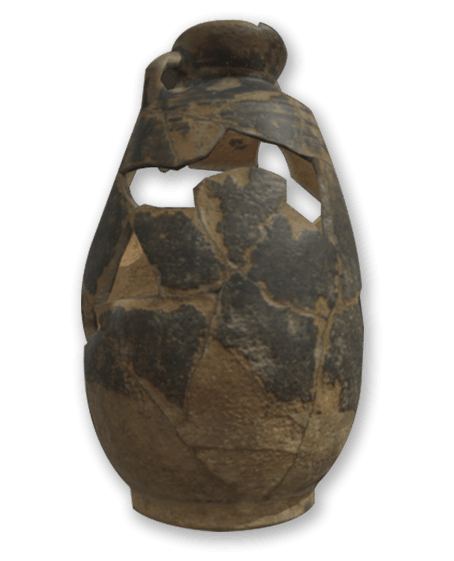
Antiques
โบราณสถานตุมปัง โบราณสถานและสิ่งศักดิ์สิทธิ์
ซึ่งเป็นที่นับถือของชาววลัยลักษณ์และชุมชนรายรอบมหาวิทยาลัย

โบราณสถานตุมปัง โบราณสถานและสิ่งศักดิ์สิทธิ์
ซึ่งเป็นที่นับถือของชาววลัยลักษณ์และชุมชนรายรอบมหาวิทยาลัย
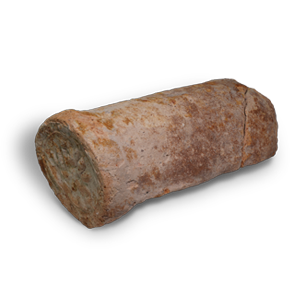
Eaves tiles are in a half-cylindrical shape. Its main utility is for covering the ridge of the roof rather than thatching other parts of it. In some pieces, patterns engraved in one end resembling eaves tiles. One whole piece of the eaves tiles was found.
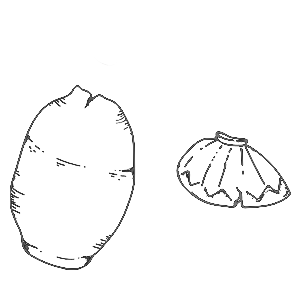
Bricks found for construction of the archeological site contain husk which resembles bricks used in the Dhavaravati culture.
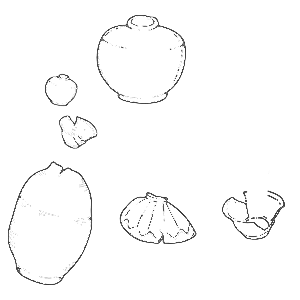
The building’s pillar base is made of carved sandstone including: 1. Form A: the pillar is in a shape quite oval with a circle groove carved for a wooden pillar to be placed in. The circle groove is not of a great depth. 2. Form B: the pillar is in a square shape with a circle groove carved for a wooden pillar to be placed. The circle groove is of a great depth.
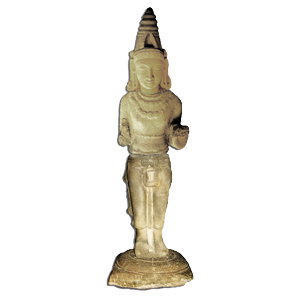
In 1983, a lower part of the statue was found which was assumed to be a lower part of a graven image of Vishnu dating from the 14th to 15th Buddhist Era leading to the interpretation that this archeological site is in Vaishnavism which is one of the sects in Hindu whose adherents worship Vishnu over other gods in Trimurti Trinity comprising Brahma, Vishnu, and Shiva.
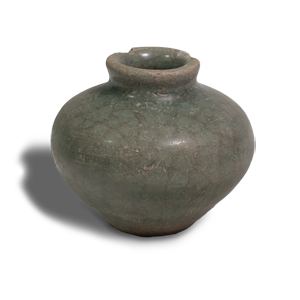
A narrow-mouth jar with spread shoulders, pencil-shaped base, smooth bottom glazed in green almost to the bottom The bowl is used as a container for medicine, ink, or other types of powdery material, and an urn to have relics buried underneath a stupa.
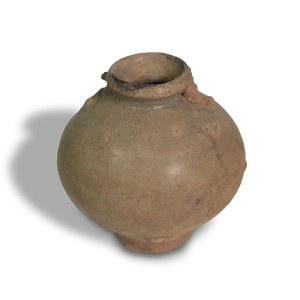
A Narrow-mouth jar with handles (broken) with the round curve body, lifted base, smooth bottom. The bowl is green-glazed (wearing out) almost to its bottom. The bowl is used as a container for medicine, ink, or other types of powdery material, and an urn to have relics buried underneath a stupa.

A narrow-mouth jar with spread shoulder lifted base and smooth bottom. The jar has its continuous scrolling blue and white floral patterns hand-printed using an underglaze method. It serves as a container for medicine, ink, or powdery substances, and also an urn to have relics buried underneath a stupa.
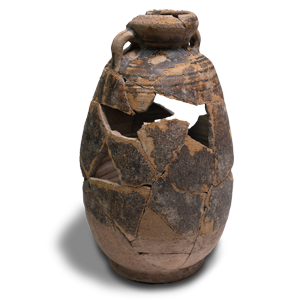
A narrow-mouth bottle with a lifted mouth’s edge, two handles, and the oval curvy body, the lifted base’s edge. Horizontal parallel lines are scraped under brown glaze extending to the bottle’s lower body. The bottle serves as a container for medicine, ink, or powdery substances, and also an urn to have relics buried underneath a stupa.
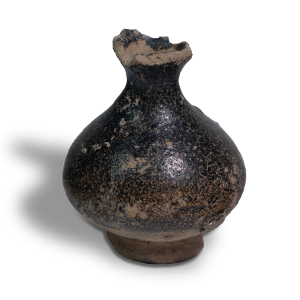
A pair-shaped bottle with a splayed mouth, pencil neck, splayed body, lifted base, and smooth bottom. Brown underglaze is applied almost to the bottle’s base. The bottle serves as a container for medicine, ink, or powdery substances, and also an urn to have relics buried underneath a stupa.
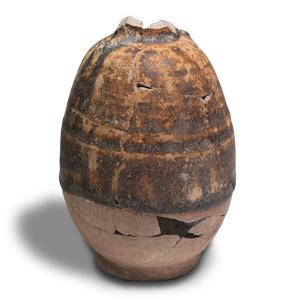
A bottle with broken mouth and neck, the oval curve body, lifted base’s edge Horizontal parallel lines are scraped under brown glaze extending to the bottle’s lower body. The bottle serves as a container for medicine, ink, or powdery substances, and also an urn to have relics buried underneath a stupa.

A clay spindle whorl is a spherical object with two flat sides, a hole at the center, and multiple descending circumference lines. A whorl is used for spinning cotton to threads.

A clay spindle whorl is a spherical object with two flat sides, a hole at the center, and multiple descending circumference lines. A whorl is used for spinning cotton to threads.
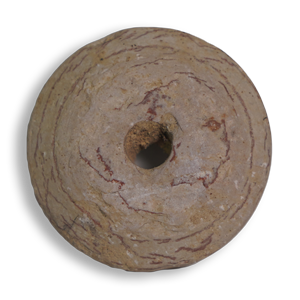
A clay spindle whorl is a spherical object with two flat sides, a hole at the center, and multiple descending circumference lines. A whorl is used for spinning cotton to threads.
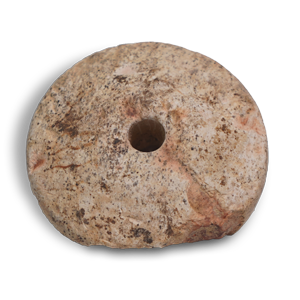
A clay spindle whorl is a spherical object with two flat sides, a hole at the center, and multiple descending circumference lines. A whorl is used for spinning cotton to threads.
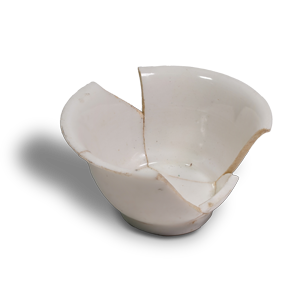
A mouth-splayed bowl with the tilted curvy body, lifted base and white glaze (worn-out). The bowl is used as a teacup.
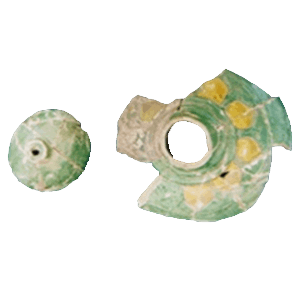
The jug has a narrow mouth and a curvy spherical body. Its spout is curvy with a narrow mouth. The jug is two-tone glazed: green glaze as a background and yellow glaze in circular shapes. The jug functions as a container for water or holy water in a ritual.
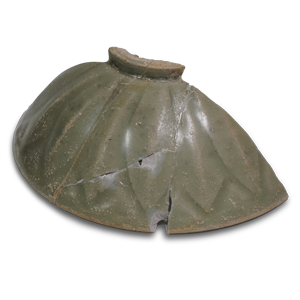
A semicircular plate with lifted base’s edge and straight cut. Lotus’s petal patterns are carved under a green glaze both on the inside and outside. The outer glaze covers the plate all the way to its base. The plate is used to serve food.
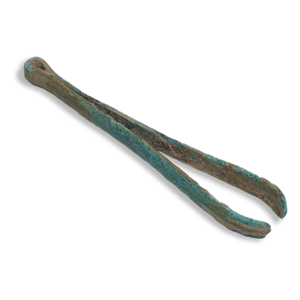
tweezers made of a bronze flat-shaped bronze piece bent to a shape of tweezers whose one end can be bent toward the other.
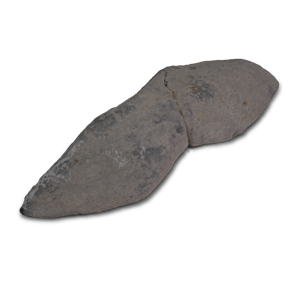
A stone bar with one end filed to the shape of a blade, and a hand-fitting handle
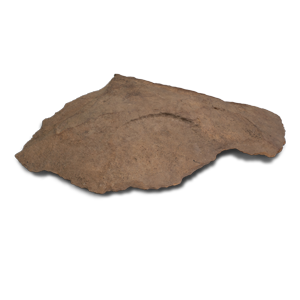
A flat piece of stone with visible traces of cracking to sharpen the edge. One end is narrow in a way resembling a handle despite its rather flat shape. The pointed ends are stone flakes breaking out of the stone core. This can be observed from the surface of the tool whose one side still displays some cracking traces.

A carved spherical sandstone disk with a non-puncturing hole at the center
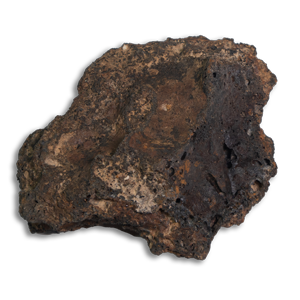
Plenty of metal dregs were found in excavations of the archeological site. Archeologists assumed that there was probably smelting despite unidentified types of metals. A Survey of the nearby areas revealed sources of iron in Ban Khao Lek in the Nopphitam district.
Name
: Eaves tiles
Size
: Width= 10 cm.
Length = 20 cm.
Thickness= 1 cm.
The end’s diameter = 8 cm.
Characteristics/ utility

Name
: Brick
Size
: Width= 15-20 cm
Length =30-35 cm
Thickness = 5-7 cm
Characteristics/ utility

Name
: Pillar base of a building
Characteristics/ utility
: The building’s pillar base is made of carved sandstone including:
1. Form A: the pillar is in a shape quite oval with a circle groove carved for a wooden pillar to be placed in. The circle groove is not of a great depth.
2. Form B: the pillar is in a square shape with a circle groove carved for a wooden pillar to be placed. The circle groove is of a great depth.
Excavation site

Name
: Avalokiteshvara or Bodhisattva Metteyya
Size
: Height = 152 cm
Base width =48 cm
Base length= 48 cm
Characteristics/ utility
: In 1983, a lower part of the statue was found which was assumed to be a lower part of a graven image of Vishnu dating from the 14th to 15th Buddhist Era leading to the interpretation that this archeological site is in Vaishnavism which is one of the sects in Hindu whose adherents worship Vishnu over other gods in Trimurti Trinity comprising Brahma, Vishnu, and Shiva.
Later in 2002, the head part and the body part of the statue were found. When put together, the statue’s iconographical features contradicted those of the Vishnu image according to traditional beliefs. First, Vishnu must be equipped with 4 hands. Second, Vishnu’s crown, specifically a missing triangle on the crown, is a defining feature of this statue.
Archeologists make a new assumption that the statue represents Bodhisattva in Mahayana Buddhism which can be Avalokiteshvara or Bodhisattva Metteyya dating back from the 16th to 18th Buddhist era because the graven image has sculptural features reflecting the influence of Southern India such as late Pallava and Chola, and Vijaya Nakhon. Additionally, the graven image has undergone some improvements localizing its features. As a result, according to these, the Tumpung archeological site should be referred to as a Buddhist monastery rather than a place of worship based on the former assumption.
Nowadays, the Bodhisattva image is being displayed at Nakhon Si Thammarat National Museum
Name
: Green-coated bowl
Size
: Height = 6 cm
Mouth = 3.2 cm
Body = 7.1 cm
Base = 3.1 cm
Thickness = 0.6 cm
Weight = 150 g
Characteristics/ utility
: A narrow-mouth jar with spread shoulders, pencil-shaped base, smooth bottom glazed in green almost to the bottom
The bowl is used as a container for medicine, ink, or other types of powdery material, and an urn to have relics buried underneath a stupa.
Excavation site
: Brick ridge
Age
: Late 18th Buddhist era – early 19th Buddhist era
Production site
: Longquan Kiln
Zhejiang province
Name
: Two-handled green jar
Size
: Height = 8 cm
Mouth = 3 cm
Body = 8 cm
Base = 3.4 cm
Thickness = 0.5 cm
Weight = 169 g
Characteristics/ utility
: A Narrow-mouth jar with handles (broken) with the round curve body, lifted base, smooth bottom. The bowl is green-glazed (wearing out) almost to its bottom. The bowl is used as a container for medicine, ink, or other types of powdery material, and an urn to have relics buried underneath a stupa.
Excavation site
: Archeological site number 3
Age
: Late 18th Buddhist era – early 19th Buddhist era
Production site
: Longquan Kiln
Zhejiang province
Name
: Underglaze blue and white bowl with handprinted patterns
Size
: Height = 5.5 cm
Mouth = 2.1 cm
Body = 6.2 cm
Base = 3.5 cm
Thickness = 0.3 cm
Weight = 102 g
Characteristics/ utility
: A narrow-mouth jar with spread shoulder lifted base and smooth bottom. The jar has its continuous scrolling blue and white floral patterns hand-printed using an underglaze method. It serves as a container for medicine, ink, or powdery substances, and also an urn to have relics buried underneath a stupa.
Excavation site
: The southern defensive wall
Age
: Late 19th Buddhist era
Production site
: Jingdezhen Kiln
Jiangxi Province
Name
: Two-handled or papaya-shaped brown-coated bottle
Size
: Height = 12.5 cm
Mouth = 3 cm
Body = 7.5 cm
Base = 4.5 cm
Thickness = 0.4 cm
Weight = 185 g
Characteristics/ utility
: A narrow-mouth bottle with a lifted mouth’s edge, two handles, and the oval curvy body, the lifted base’s edge. Horizontal parallel lines are scraped under brown glaze extending to the bottle’s lower body. The bottle serves as a container for medicine, ink, or powdery substances, and also an urn to have relics buried underneath a stupa.
Age
: Mid 21st Buddhist era
To
Early 22nd Buddhist era
Production site
: Si Satchanalai Kiln (Pa yang)
Name
: Pair-shaped brown-glazed bottle
Size
: Height = 7.5 cm
Mouth = can’t be measured
Body = 6.3 cm
Base = 3.1 cm
Thickness = 0.4 cm
Weight = 95 g
Characteristics/ utility
: A pair-shaped bottle with a splayed mouth, pencil neck, splayed body, lifted base, and smooth bottom. Brown underglaze is applied almost to the bottle’s base. The bottle serves as a container for medicine, ink, or powdery substances, and also an urn to have relics buried underneath a stupa.
Excavation site
: Archeological site number 3
Age
: Mid 21st Buddhist era
To
Early 22nd Buddhist era
Production site
: Si Satchanalai Kiln (Pa yang)
Name
: Two-handled brown-glazed bottle
Size
: Height = 9.5 cm
Mouth = can’t be measured
Body = 6.9 cm
Base = 4.3 cm
Thickness = 0.5 cm
Weight = 153 g
Characteristics/ utility
: A bottle with broken mouth and neck, the oval curve body, lifted base’s edge Horizontal parallel lines are scraped under brown glaze extending to the bottle’s lower body. The bottle serves as a container for medicine, ink, or powdery substances, and also an urn to have relics buried underneath a stupa.
Age
: Mid 21st Buddhist era
To
Early 22nd Buddhist era
Production site
: Si Satchanalai Kiln (Pa yang)
Name
: Clay spindle whorl
Size
: Outer circumference= 3 cm
Inner circumference = 0.5 cm
Thickness = 1.9 cm
Weight = 22 g
Characteristics/ utility
Name
: Clay spindle whorl
Size
: Outer circumference= 3.3 cm
Inner circumference = 0.5 cm
Thickness = 1.4 cm
Weight = 19 g
Characteristics/ utility
Name
: Clay spindle whorl
Size
: Outer circumference= 3 cm
Inner circumference = 0.5 cm
Thickness = 1 cm
Weight = 11 g
Characteristics/ utility

Name
: White-glazed bowl
Size
: Height = 4 cm
Mouth= 7.2 cm
Base = 0.2 cm
Thickness = 0.4 cm
Weight = 44 g
Characteristics/ utility
: A mouth-splayed bowl with the tilted curvy body, lifted base and white glaze (worn-out). The bowl is used as a teacup.
Age
: First half of the 22nd Buddhist era
Production site
: Jingdezhen kiln
Jiangxi province
Ming dynasty
Name
: Two-tone glazed jug (glazed in yellow and green)
Size
: Can’t be measured because the parts are broken.
Characteristics/ utility
: The jug has a narrow mouth and a curvy spherical body. Its spout is curvy with a narrow mouth. The jug is two-tone glazed: green glaze as a background and yellow glaze in circular shapes. The jug functions as a container for water or holy water in a ritual.
Age
: Mid 21st Buddhist era
To
Early 22nd Buddhist era
Production site
: Xue Chao kiln
Fujian province

Name
: Green-glazed plate with lotus’s petal patterns carved on the outer surface
Size
: Height = 5.5 cm
Mouth= 16.5 cm
Base = 0.5 cm
Thickness = 4.3 cm
Weight = 153 g
Characteristics/ utility
: A semicircular plate with lifted base’s edge and straight cut. Lotus’s petal patterns are carved under a green glaze both on the inside and outside. The outer glaze covers the plate all the way to its base. The plate is used to serve food.
Excavation site
: Excavation pit N3W6 located to the west of the archeological site
Age
: Late 18th Buddhist era
To Early 19th Buddhist era
Production site
: Longquan Kiln
Zhejiang province

Name
: Bronze tweezers
Size
: Length = 10 cm
Characteristics/ utility
: tweezers made of a bronze flat-shaped bronze piece bent to a shape of tweezers whose one end can be bent toward the other.
Excavation site
Name
: Stone tool
Size
: Width= 4.5 cm
Length = 16.5 cm
Thickness = 3 cm
Weight = 310 g
Characteristics/ utility

Name
: Stone tool
Size
: Width= 11 cm
Length = 19 cm
Thickness = 1.1 cm
Weight = 225 g
Characteristics/ utility

Name
: A carved spherical sandstone disk
Size
: Outer diameter = 13 cm
Inner diameter= 3.3 cm
Thickness = 3 3 cm
Weight = 801 g
Characteristics/ utility
: A carved spherical sandstone disk with a non-puncturing hole at the center
Excavation site
Name
: Metal dregs
Size
: Weight = 150 g
Characteristics/ utility
: Plenty of metal dregs were found in excavations of the archeological site. Archeologists assumed that there was probably smelting despite unidentified types of metals. A Survey of the nearby areas revealed sources of iron in Ban Khao Lek in the Nopphitam district.
Excavation site